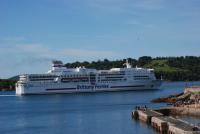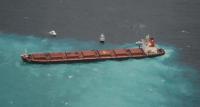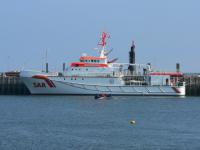-
Furloughed Port, Airport Workers Could Be Targeted by Organized Crime
The U.K. National Crime Agency has issued an alert to furloughed port and airport workers warning they may be vulnerable to organized crime groups seeking to exploit the Covid crisis. The alert warns that as global restrictions on the movement of people and goods are further relaxed, staff who have a detailed knowledge of controls and processes around the border could be targeted.
-
-
Why You Should Expect More Suez-Like Supply Chain Disruptions and Shortages at Your Local Grocery Store
When the Ever Given container ship choked off traffic in the Suez Canal for almost a week in late March 2021, it made big headlines around the world. Yet many people I spoke with, including students and professional colleagues, didn’t seem to have a clue about what was happening, why it mattered or how it affects them.
-
-
Suez Canal Container Ship Accident Is a Worst-Case Scenario for Global Trade
It’s estimated that 90 percent of the world’s trade is transported by sea. As consumers, we rarely give much thought to how the things we buy make their way across the planet and into our homes. That is, until an incident like the recent grounding of a huge container ship, the Ever Given, in the Suez Canal exposes the weaknesses in this global system.
-
-
Gulf of Guinea Piracy: A Symptom, Not a Cause, of Insecurity
Piracy in the Gulf of Guinea appears to be worse than ever, judging by recent headlines. But these accounts and the data they rely on must be approached with caution. Figures on piracy and armed robbery at sea are susceptible to under-reporting and problems of definition. Over-hasty responses could lead to narrow solutions that fail to solve the underlying causes of maritime insecurity.
-
-
Tackling Cargo Shipping Security
Each day, thousands of containers travel the globe. Security agencies need to ensure the cargo that originally was shipped in them is what is in them when they reach their destination. Harmful or illegal content, added after the cargo was cleared for transport, must be detected and intercepted. Securing the global supply chain, while ensuring its smooth functioning, is essential to U.S. national security.
-
-
Driverless ferries to replace footbridges
As towns grow, the need arises for more river and canal crossings. But bridges are expensive and hinder the flow of boat traffic. An autonomous and self-propelled passenger ferry that can “see” kayakers and boats, and that shows up right when you need it, could be an ingenious substitute for footbridges. Soon the prototype for the world’s first driverless electric passenger ferry will be ready to launch in Trondheim, Norway.
-
-
Why 50,000 ships are so vulnerable to cyberattacks
The 50,000 ships sailing the sea at any one time have joined an ever-expanding list of objects that can be hacked. Cybersecurity experts recently displayed how easy it was to break into a ship’s navigational equipment. This comes only a few years after researchers showed that they could fool the GPS of a superyacht into altering course. Once upon a time objects such as cars, toasters and tugboats only did what they were originally designed to do. Today the problem is that they all also talk to the internet. The maritime industry is undoubtedly behind other transportation sectors, such as aerospace, in cybersecurity terms. There also seems to be a lack of urgency to get the house in order. So the maritime industry seems particularly ill-equipped to deal with future challenges, such as the cybersecurity of fully autonomous vessels.
-
-
Detecting nuclear materials used in dirty bombs
Radiological material falling into the wrong hands is a constant security concern for governments around the world. Border agencies must scan incoming vehicles and freight for radioactive material, which is a challenging task, as huge volumes of both move across borders each day. Imperial College London’s physicists have developed two devices for detecting nuclear materials.
-
-
New app helps improve radiation detection at ports
Evaluating radiation alarms represents a huge challenge for inspectors at seaports scanning containers for radioactive materials. Each alarm requires inspectors to perform secondary inspections on dozens of containers a day. A new smart phone application launched by the IAEA will help distinguish between alarms due to harmless amounts of naturally occurring radiation and alarms that might be a cause for concern from a security standpoint and warrant further investigation.
-
-
Cybersecurity to bolster safe transfer of hazardous liquids at ports
The U.S. Coast Guard (USCG) oversees approximately 800 waterfront facilities that, among other activities, transfer hazardous liquids between marine vessels and land-based pipelines, tanks or vehicles. These “maritime bulk liquid transfers” increasingly rely on computers to operate valves and pumps, monitor sensors, and perform many other vital safety and security functions. This makes the whole system more vulnerable to cybersecurity issues ranging from malware to human error, and is the reason behind a new voluntary cybersecurity guide for the industry.
-
-
Bermuda Triangle mystery may have been solved
It is estimated that over the last 100 years, hundreds of ships, at least 75 planes, and thousands of lives have been lost art the Bermuda Triangle. A group of satellite meteorologists may have solved the mystery of the triangle: Hexagonal clouds, creating “air-bombs” with winds of up to 170mph, capable of plunging planes into the sea and flipping ships, are said to be behind the mysterious disappearances at sea.
-
-
Armed French police deployed on Channel ferries

Passenger ferries going between Britain and France are now being accompanied by armed sea patrols to protect them from jihadist attacks. In addition, marine gendarmes are now placed on ferries in the Channel and North Sea, as the two countries are in talks about allowing French security personnel togo on board ferries before the ferries leave English ports.
-
-
Maritime vessels at risk of cyberattack because of outdated systems

Maritime vessels are under significant threat of cyber-attack because many are carrying outdated software and were not designed with cyber security in mind, according to new research. But operators could easily mitigate against such dangers by updating security systems, improving ship design and providing better training for crews.
-
-
Improving detection of concealed nuclear materials

Researchers have demonstrated proof of concept for a novel low-energy nuclear reaction imaging technique designed to detect the presence of “special nuclear materials” — weapons-grade uranium and plutonium — in cargo containers arriving at U.S. ports. The method relies on a combination of neutrons and high-energy photons to detect shielded radioactive materials inside the containers.
-
-
Mathematics helps search and rescue ships sail more safely in heavy seas

Fast ships deliver all kinds of services in fields such as disaster response, the fight against crime, the provision of supplies for oil and gas platforms, and the transportation of wind farm maintenance personnel. Each year, however, around 100 such ships worldwide are lost or damaged in heavy seas, with around 2,500 casualties in 2013. A unique new computer model built on highly complex mathematics could make it possible to design safer versions of the “fast ships” widely used in search-and-rescue, anti-drugs, anti-piracy, and many other vital offshore operations.
-
- All
- Regional
- Water
- Biometrics
- Borders/Immig
- Business
- Cybersecurity
- Detection
- Disasters
- Government
- Infrastructure
- International
- Public health
- Public Safety
- Communication interoperabillity
- Emergency services
- Emergency medical services
- Fire
- First response
- IEDs
- Law Enforcement
- Law Enforcement Technology
- Military technology
- Nonlethal weapons
- Nuclear weapons
- Personal protection equipment
- Police
- Notification /alert systems
- Situational awareness
- Weapons systems
- Sci-Tech
- Sector Reports
- Surveillance
- Transportation
Advertising & Marketing: advertise@newswirepubs.com
Editorial: editor@newswirepubs.com
General: info@newswirepubs.com
2010-2011 © News Wire Publications, LLC News Wire Publications, LLC
220 Old Country Road | Suite 200 | Mineola | New York | 11501
Permissions and Policies
Editorial: editor@newswirepubs.com
General: info@newswirepubs.com
2010-2011 © News Wire Publications, LLC News Wire Publications, LLC
220 Old Country Road | Suite 200 | Mineola | New York | 11501
Permissions and Policies
